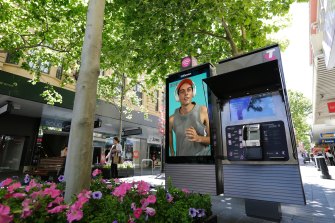
Telstra receives $40 million annually from the sector to maintain the phones. Most of this money comes directly from Telstra’s pocket, but competitors such as TPG Telecom and Optus SingTel also assist with the cost (Telstra pays roughly three times the amount of its competitors).
Loading
And two weeks ago, Optus and NBN Co publicly declared they did not want to provide ongoing funding. Optus said the arrangement was a “mess of outdated, poorly managed and costly arrangements”, while NBN Co said the department needed to review the payphone service to determine whether it “continues to deliver benefits to end users who outweigh the costs”.
The comments were made in submissions to the government as part of broader calls to reform the universal services’ agreement. But they were not the first comments about payphone subsidies.
A submission by the Australian Communications Consumer Action Network to a recent consultation by the Australian Communications and Media Authority said public payphones are often non-operational and are scarce in regional areas.
Vodafone Australia said in a submission to the Telecommunications Universal Service Obligation inquiry in 2017 that Telstra was receiving gains from running the phones and there was no need to subsidise it given the money it could make from advertising on the phones and Wi-Fi services.
Arena says the amount it makes from the phones - which isn’t publicly disclosed - is not enough to offset the costs of running it. “It’s absolutely not a contributor to profitability for us and I know there’s a perception of that,” he says. “But a lot of the advertising you see on those phones is our own media. It’s not a massive money-spinner for us.
“There’s still a cost to us - we still clean, we maintain, and we have to migrate those payphones off copper onto new technologies over time, and we still shoulder the responsibility to do that as well.”
In an effort to improve accessibility, Telstra made the phones free to use last August. Outgoing Telstra chief executive Andy Penn said at the time it was important to make payphones free so that vulnerable people - facing natural disasters, homeless or fleeing domestic violence - had the ability to call someone.
“The move to make all phones free was not just about helping the community. On top of maintenance and cleaning costs, collecting coins also costs money,” says Arena.

JCDecaux and Telstra's revamped payphones with ad billboards.Credit:JCDecaux
One person who has seen the effects of making the phones free is Major Brendan Nottle, who leads The Salvation Army in Melbourne. He says the decision has already helped disadvantaged people get better access to services and reduce loneliness.
“Often people that are homeless or at risk of homelessness or are dealing with complex mental health issues … the one issue that we see over and over again is if people do have a mobile phone - and many of them do - they often lose it, or they lose the charger, or they run out of credit.
“They’re often a group of people that need access to other people for a number of reasons … to access services, food, accommodation options or they need to follow up with Centrelink. Having access to a phone is critical. The other issue that we see is this whole idea of social poverty and social isolation. Being able to pick up a payphone is a really helpful bridge that people can use to reconnect with people,” he says.
Nottle says he has seen an increase in usage since the phones were made free. A payphone across the road from the Salvos head office on Bourke St, Melbourne, has had queues of up to three or four people at times.
Loading
“Word got out that the payphone was free,” he says. “It just spread to the point where there were a couple of times early on where there was a queue to use it.”
The telco sector does not disagree with the idea that these phones serve vulnerable parts of the community. But Telstra’s rivals do not think it needs millions of dollars to deliver the service and now there are question marks about their future.
“If you don’t continue to make them relevant in society and continue to upgrade and maintain - and we’re doing that with USB charging, you can make text messages you can send from phones now, emergency messaging - then at some point in the future, someone’s going to say well, this is not relevant,” Arena says.
One attempt to continue their relevance was Telstra’s deal with outdoor advertising giant JCDecaux in 2017. But the attempt to revitalise the city caused all sorts of problems. A messy legal battle between Telstra and the City of Sydney over the installation of new public phones led to the replacement of modern devices with older models to ensure the council’s advertising partner, QMS Media, had exclusivity in the CBD.
“We now have to simply just follow the required planning laws, which take a bit longer,” Arena says.
But even with council approval, it’s unlikely there will ever be as many payphones as there were previously. Telstra says it needs to rethink what the phone looks like as the world evolves.
“We have 15,000 locations where we have a bit of land, power and internet. There are opportunities not just for USB charging, but for light electric vehicle charging such as scooters, you could potentially put automated external defibrillators into our network,” Arena says.
“We believe they have a place in the digital economy and digital society of the future.”









 Add Category
Add Category